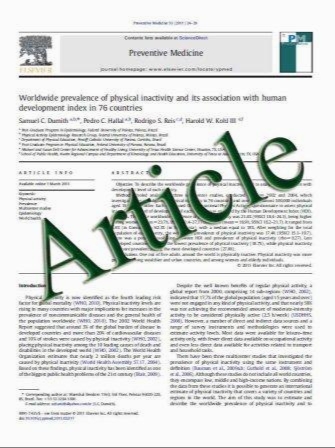Associations of physical activity duration, frequency, and load with volumetric BMD, geometry, and bone strength in young girls
- نوع فایل : کتاب
- زبان : انگلیسی
- مؤلف : J. N. Farr & R. M. Blew & V. R. Lee & T. G. Lohman & S. B. Going
- چاپ و سال / کشور: 2010
Description
Summary More efficacious physical activity (PA) prescriptions for optimal bone development are needed. This study showed that PA duration, frequency, and load were all independently associated with bone parameters in young girls. Increased PA duration, frequency, and load are all important osteogenic stimuli that should be incorporated into future PA interventions. Introduction This study evaluated the associations of physical activity (PA) duration, frequency, load, and their interaction (total PA score=durationپ~frequencyپ~load) with volumetric bone mineral density, geometry, and indices of bone strength in young girls. Methods Four hundred sixty-five girls (aged 8.13 years) completed a past year physical activity questionnaire (PYPAQ) which inquires about the frequency (days per week) and duration (average minutes per session) of leisure-time PA and sports. Load (peak strain score) values were assigned to each activity based on ground reaction forces. Peripheral quantitative computed tomography was used to assess bone parameters at metaphyseal and diaphyseal sites of the femur and tibia of the nondominant leg. Results Correlations across all skeletal sites between PA duration, frequency, load and periosteal circumference (PC), bone strength index (BSI), and strength-strain index (SSI) were significant (p.0.05), although low (0.10.0.17). A 2.7.3.7% greater PC across all skeletal sites was associated with a high compared to a low PYPAQ score. Also, a high PYPAQ score was associated with greater BSI (6.5.8.7%) at metaphyseal sites and SSI (7.5.8.1%) at diaphyseal sites of the femur and tibia. The effect of a low PYPAQ score on bone geometric parameters and strength was greater than a high PYPAQ score. Conclusions PA duration, frequency, and load were all associated with bone geometry and strength, although their independent influences were modest and site specific. Low levels of PA may compromise bone development whereas high levels have only a small benefit overmore average levels.
Osteoporos Int (2011) 22:1419–1430 DOI 10.1007/s00198-010-1361-8 Received: 6 April 2010 / Accepted: 13 July 2010 / Published online: 7 August 2010


